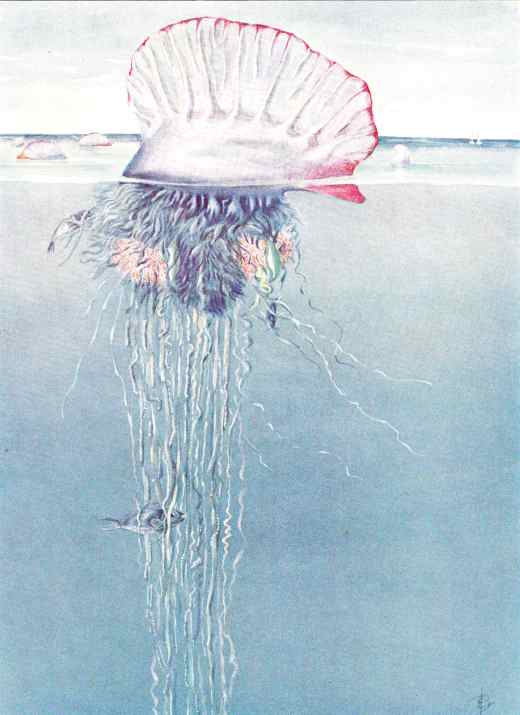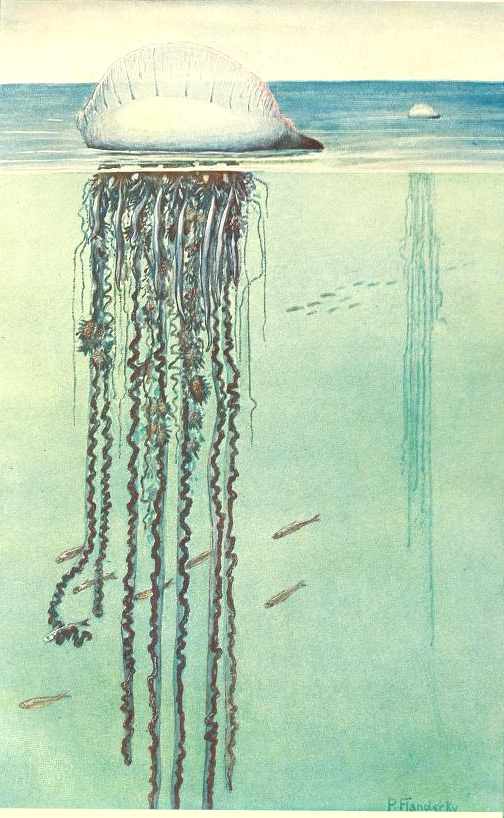Portuguese man o' war
This is a large and also dangerous jellyfish-like animal that floats onm the surface of the oceans. The length of the tentacles is often more then 20 meters. The sting is extremely painfull. They can be found in large groups, with often more then 1000 members.
Portuguese man o' war consists of 4 polyps.
Although this animal looks like one organism, it are infact 4 polyps working together. The man-of-war belongs to the Siphonophorae, that belong to the Cnidaria. It is a evolutionary path in which organism work together to form one organism.
Pneumatofore of the man-of-war
One of polyps is called the pneumatofore, it depends on the other polyps to stay alive. Its task is to keep the man-of-war floating. It fills the balloon or bottle with a gas, depending on the wheather. If its stormy wheather, the man of war remains deeper in the sea. The gas can escape through valves.The gas is almost only nitrogen, delivered by the other polyps. The pneumatofore can stay alive for a ong time , without the help of the other polyps. So the pneumatofore can found on the beaches without the other polyps.
Dactylozo´den: they form the tentacles and paralyze the prey with there venom, produced by the nematocytes.
After paralyzing the prey, the tentacles roll up and the prey is brought to digestive polyps.
The gastrozo´des: these polyps feed on the prey and distribute the food.
The gonozo´des: these are the reproduction organs..
The gonozo´des
The gonozoides produce both eggs and sperm, but not at the same time.
Gametes are spawned in the water and fertilization is in the sea. The fertilized eggs form a small polyp, that floats between other plankton,
this is called meroplankton.
enemies of the man of war
By far, the biggest enemies of the man of war are storms, they bring the man-of-war to the coast, were they will decay. It is rare for only a single Portuguese man o' war to be found; often the finding of one results in the finding of many other, as they form large schools. But there are also some animals that are unvulnerable for the poison: The loggerhead turtle feeds on the Portuguese man o' war, but hunting has declined there numbers. This is probably the reason the there is an incline in the number of the man-of-war. The sea slug Glaucus atlanticus also feeds on the Portuguese man o' war, This slug is part of the plankton, as does the violet snail Janthina janthina. This snail is a marine gastropod mollusk that drift on the surface of the ocean, waiting for its prey: mostly a man-of-war or by-the-wind sailor.

If there is a calm see, the man of war will inflate the bottle and sail on the wind. In stormy wheather the man of war will sink to just under the surface. An illustration of Hashime Murayama.
The sting of the man o' war
The sting causes severe dermatitis, very painful, but is almost never deadly. don't use vinegar, it will worsen the problem.
Pacific man of war of Physalia utriculus
This is the smaller version of the Atlantic man of war and also less dangerous. This animal is the cause of many acidents on Australian beaches.
man o' war siphonophore
Although mostly called a jellyfish, the man o' war is actually a siphonophore. Siphonophores look like a single organism but they're not, they're actually a colonial organism made up of little individuals called zooids. Zooids are attached to each other and completely dependent on each.

Man-of-war feeding on fish , an illustration of Brehm.
evolution of the man o' war
The fusion of the four polyps is lonely road in the evolution. It still puzzles scientists. There are few other organism that show the same pathway, but ants and bees (social insects) form colonies with very different members.
